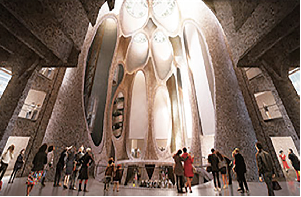
‘What does that design mean?’ Many people think designing is difficult, and understanding the essence of the design is more difficult when they find themselves at a design exhibition. However, think about the red double-decker buses in the U.K or the benches at public parks. Design is a part of our lives. Here, one English designer today is using his creativity to improve our everyday lives with innovative designs. His name is Thomas Heatherwick. At the exhibition, New British Inventors Inside Heatherwick Studio, one is given the opportunity to feel the essence of designing.

Thinking: The Start of a Design
Thomas Heatherwick is a world renowned designer from the U.K who brings his own flare to his work. In 1994, he established ‘Heatherwick Studio’ to break design conventions that followed a set formula. Today, he has gained fame throughout the world for his work. To build his studio, he employed a number of designers, architects, and city planners. Since 1994, Heatherwick and his studio team have worked on a number of big projects around the world like the British Pavilion at Expo Shanghai, the Cauldron for London Olympics, and London bus revitalization. Currently, the Studio is working on over 30 projects at the same time, and some of the projects include the Google building in LA and a new museum in South Africa. At D Museum, visitors are introduced to the work of Heatherwick and his studio through pictures, videos, and crafts. The Museum also shows a video in which visitors watch recorded interviews with studio members. Also, guests at the Museum learn how to design well and how actual designs were created. D Museum is near Sookmyung Women’s University. Bus 2016 will get you there in just about 50 minutes. At first glance, D Museum may appear small, but once you are inside, visitors are amazed by the amount of information that helps design understanding.

Making: Improve the Quality of Life
Most of Heatherwick’s projects are big. He typically designed buildings, so the exhibition consists mostly of pictures and models. His work also includes: bridges, chairs, and buses. When one first thinks of a bridge, the words steel and solid come to mind. However, Heatherwick designed a bridge that could be folded, so it actually looks round. His design is both unique in appearance and comfortable to use. If one needs the bridge to cross the street, the person simply unfolds the bridge, and when it’s not needed, the person then folds the bridge back up and removes it from the street. It allows space to be used very effectively. In terms of chair design, by merely looking at Heatherwick’s design, one may ponder what it is exactly. The chair name is ‘Spun-Hula!’ because when one sits down on it, the chair spins about and it lit up by sensors and mechanisms. Interestingly, the chair responds to subtle environmental changes. The simple chair can be meant to be fun. Most people think of the red double-deck bus and the clock tower when they think of the U.K. Heatherwick renewed the bus that we see today. In other words, he created the bus design all people throughout the world recognize as uniquely British. The most interesting aspect of the design is that Heatherwick restyled the seats after looking at passengers’ shadows. The buses now have seats that are patterned after passenger shadows.
His designed buildings are too large for D Museum to showcase, but after viewing them in pictures, guests to the Museum will certainly want to see them firsthand. Heatherwick refrained from the typical building design. Each of his buildings has a special meaning, and the shape and features of the buildings are in line with their meanings. For instance, the greenhouse structure is made of only clear glass and his library building inspires one’s passion for learning. Also, other buildings that he designed clearly highlight the cooperative effort by all involved in their creation.

Storytelling: Listen to Design
When this reporter thought about design, I found it hard to see how it affects everyday life. However, after visiting the exhibition, I soon realized how design can improve all aspects of our life by giving them a bit more beauty. Moreover, understanding of an artist’s design became simpler. I recommend visiting this exhibition to anyone unfamiliar with design as well anyone interested in design. It was a bit disappointing to have to see the actual buildings only through photographs or models, but the models and images were so specific that everyone will most certainly feel the originality of the buildings and be inspired to someday see the building firsthand.



